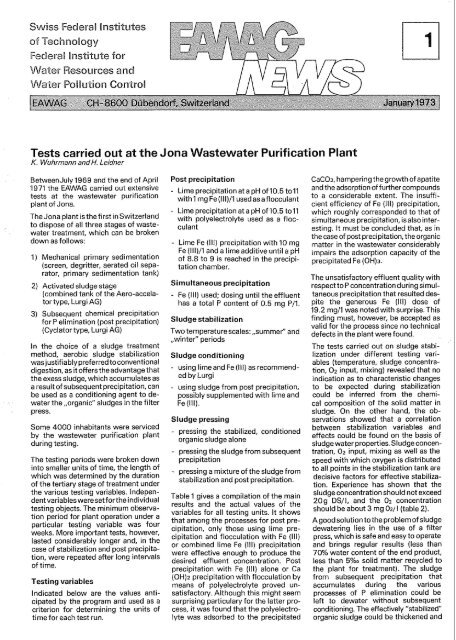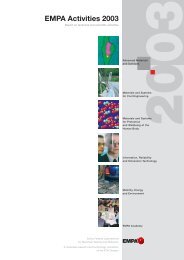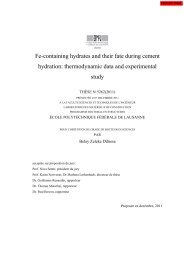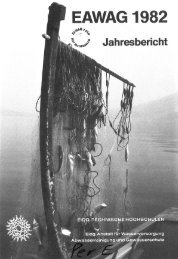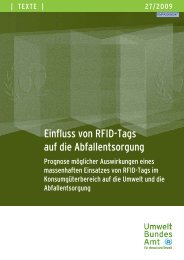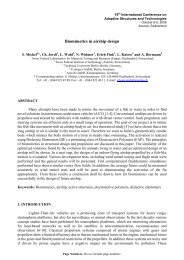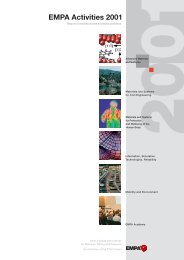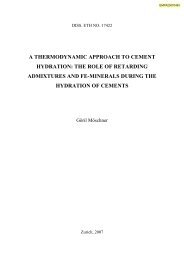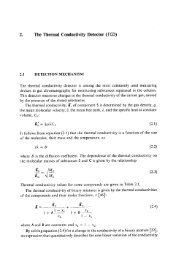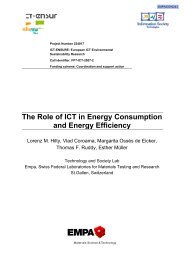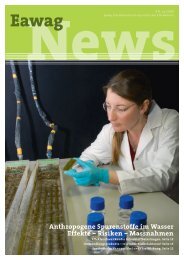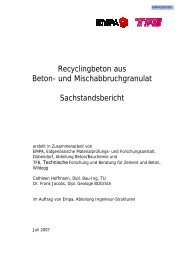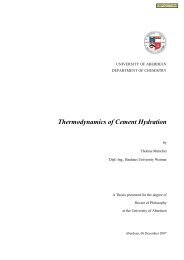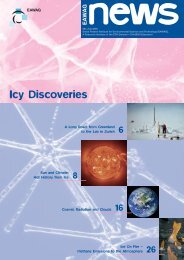Eawag News 1 (1973) (English) - Eawag-Empa Library / Empa ...
Eawag News 1 (1973) (English) - Eawag-Empa Library / Empa ...
Eawag News 1 (1973) (English) - Eawag-Empa Library / Empa ...
You also want an ePaper? Increase the reach of your titles
YUMPU automatically turns print PDFs into web optimized ePapers that Google loves.
Swiss Federal institutes<br />
of Technology<br />
Federal institute for<br />
Water Resources and<br />
Water Pollution Control<br />
~EAWAG CH - 8600 Diibendorf, Switzerland .Ianuaryi9?3l<br />
Tests carried out at the Jona Wastewater Purification Plant<br />
K. Wuhrrnann andH. Leidner<br />
BetweenJuly 1969 and the end of April<br />
1971 the EAWAG carried out extensive<br />
tests at the wastewater purification<br />
plant of Jona.<br />
The Jona plant isthefirst inSwitzerland<br />
to dispose of all three stages of waste-<br />
water treatment, which can be broken<br />
down as follows:<br />
1) Mechanical primary sedimentation<br />
(screen, degritter, aerated oil separator,<br />
primary sedimentation tank)<br />
2) Activated sludge stage<br />
(combined tank of the Aero-accelatortype,<br />
Lurgi AG)<br />
3) Subsequent chemical precipitation<br />
for P elimination (post precipitation)<br />
(Cyclatortype, Lurgi AG)<br />
In the choice of a sludge treatment<br />
method, aerobic sludge stabilization<br />
wasjustifiably preferredtoconventional<br />
digestion, as it offers theadvantagethat<br />
the exess sludge, which accumulates as<br />
a result of subsequent precipitation, can<br />
be used as a conditioning agent to de-<br />
water the ,,organic" sludges in the filter<br />
press.<br />
Some 4000 inhabitants were serviced<br />
by the wastewater purification plant<br />
during testing.<br />
The testing periods were broken down<br />
into smaller units of time, the length of<br />
which was determined by the duration<br />
of the tertiary stage of treatment under<br />
the various testing variables. Indepen-<br />
dentvariablesweresetfortheindividual<br />
testing objects. The minimum observa-<br />
tion period for plant operation under a<br />
particular testing variable was four<br />
weeks. More important tests, however.<br />
lasted considerably longer and, in the<br />
case of stabilization and post precipita-<br />
tion, were repeated after long intervals<br />
of time.<br />
Testing variables<br />
Indicated below are the values anticipated<br />
by the program and used as a<br />
criterion for determining the units of<br />
time for each test run.<br />
Post precipitation<br />
- L~me precipitation at a pH of 10.5 toll<br />
with1 mg Fe(lIlj11 usedasaflocculant<br />
- Lime precipitation at a pH of 10.5 toll<br />
with polyelectrolyte used as a flocculant<br />
- Lime Fe (Ill) precipitation with 10 mg<br />
Fe (III)/l and a limeadditive until a pH<br />
of 8.8 to 9 is reached in the precipi-<br />
tation chamber.<br />
Simultaneous precipitation<br />
- Fe (Ill) used; dosing until theeffluent<br />
has a total P content of 0.5 mg P/1.<br />
Sludgestabilization<br />
Two temperaturescales: ,,summerw and<br />
,,wintere' periods<br />
Sludge conditioning<br />
- using limeand Fe (Ill) as recommended<br />
by Lurgi<br />
- using sludge from post precipitation.<br />
possibly supplemented with lime and<br />
Sludge pressing<br />
- pressing the stabilized, conditioned<br />
organic sludge alone<br />
- pressing the sludge from subsequent<br />
precipitation<br />
- pressing a mixture of the sludge from<br />
stabilization and post precipitation.<br />
Table 1 gives a compilation of the main<br />
results and the actual values of the<br />
variables for all testing units. It shows<br />
that among the processes for post pre-<br />
cipitation, only those using lime pre-<br />
cipitation and flocculation with Fe (Ill)<br />
or combined lime Fe (Ill) precipitation<br />
were effective enough to produce the<br />
desired effluent concentration. Post<br />
precipitation with Fe (Ill) alone or Ca<br />
(OH)> precipitation with flocculation by<br />
means of polyelectrolyte proved un-<br />
satisfactory. Although this might seem<br />
surprising particulary for the latter pro-<br />
cess, it was found that the polyelectro-<br />
lyte was adsorbed to the precipitated<br />
CaC03, hamperingthegrowthof apatite<br />
and the adsorption of further compounds<br />
to a considerable extent. The insuffi-<br />
cient efficiency of Fe (Ill) precipitation,<br />
which roughly corresponded to that of<br />
simultaneous precipitation, isalso inter-<br />
esting. It must be concluded that, as in<br />
the case of post precipitation, the organic<br />
matter in the wastewater considerably<br />
impairs the adsorption capacity of the<br />
precipitated Fe (OH)&<br />
The unsatisfactory effluent quality with<br />
respect to P concentration duringsimultaneous<br />
precipitation that resulted despite<br />
the generous Fe (Ill) dose of<br />
19.2 mg/l was noted with surprise.This<br />
finding must, however, be accepted as<br />
valid for the process since no technical<br />
defects in the ~lant were found.<br />
The tests carried out on sludge stabilization<br />
under different testing variables<br />
(temperature, sludge concentration,<br />
02 input, mixing) revealed that no<br />
indication as to characteristic changes<br />
to be expected during stabilization<br />
could be inferred from the chemical<br />
composition of the solid matter in<br />
sludge. On the other hand, the observations<br />
showed that a correlation<br />
between stabilization variables and<br />
effects could be found on the basis of<br />
sludgewaterproperties.Sludgeconcentration,<br />
02 input, mixing as well as the<br />
speed with which oxygen is distributed<br />
to all points in the stabilization tank are<br />
decisive factors for effective stabilization.<br />
Experience has shown that the<br />
sludge concentration should not exceed<br />
209 DS/I, and the 02 concentration<br />
should be about 3 mg 021 1 (table 2).<br />
Agood solution tothe problemof sludge<br />
dewatering lies in the use of a filter<br />
press, which is safe and easy to operate<br />
and brings regular results (less than<br />
70% water content of the end product,<br />
less than 5%0 solid matter recycled to<br />
the plant for treatment). The sludge<br />
from subsequent precipitation that<br />
accumulates during the various<br />
processes of P elimination could be<br />
left to dewater without subsequent<br />
conditioning. The effectively "stabilized<br />
organic sludge could be thickened and
easily dewatered after conditioning with advantageous conditioning method tion without adding any further chemi-<br />
lime and Fe (Ill). From the economic was to mix the .,stabilized, organic cals: this mixture is the easiest to de-<br />
and operational point of view, the most sludge with sludge from post precipita- water.<br />
Table 7; P eliminafion<br />
79.4 1 7.6 8.9 3.4 5.3<br />
95.7 11.1<br />
98.2 9.5<br />
Post Mean<br />
-<br />
precipi-<br />
173.2 1.4 /10.8- 6.4 1 9.6<br />
1 7.9 0.24 92.8 30 sam'plings<br />
I / Mean 1<br />
I I 1 I ; 91.9 1<br />
I<br />
System<br />
Sirnuit.-<br />
precipit.<br />
Test<br />
Number<br />
/ I Y I 1 I-,, / 1 U ,<br />
OA18<br />
'Calculated on the basis of concentrations<br />
"PE = Polyelectrolyte<br />
pH in<br />
reactor<br />
Table 2: Sludge stabilization (Composition of the sludge water)<br />
NO. Stabilizer<br />
Dose<br />
Ca (OH)! Fe3;<br />
mgll I mgll<br />
1 19.2<br />
I<br />
Pb (1I)Species in Natural Waters<br />
by Halka Bilinskiand WernerStumm<br />
The rate of release of lead exceeds the<br />
rate of natural circulation. Approxima-<br />
telyl million tons of Pb is introduced per<br />
year into the geosphere.Approximately<br />
75% of this quantity enters the waters.<br />
In order to understand the distribution<br />
of lead in naturalwaters(sedimentation.<br />
adsorption,association withsuspended<br />
materials, incorporation into the food<br />
chain) and its possibletoxicity, informa-<br />
tion on the forms of occurrence of Pb in<br />
dissolved and solid phases is necessary.<br />
With the help of anodic stripping (inversevoltammetry)<br />
using hanging drop<br />
mercury electrodes, the speciation of<br />
lead(ll) in dependence of solution variables<br />
(pH, alkalinity, organic ligands) has<br />
been investigated. Because of its great<br />
sensitivity, inversevoltammetry permits<br />
to investigate the solution behavior in<br />
the pH range of natural waters without<br />
precipitating of thesolid phases.<br />
PE"<br />
mg/l<br />
Primary effluent<br />
ortho-P total P<br />
mg PI1 mg PI1<br />
"U ,<br />
,,U<br />
Final effluent<br />
ortho-P 1 total P I total P<br />
mg PI1 1 mg PI1 %elim.'<br />
/ ","I / ,,I I , 4 1<br />
I<br />
1 7.1 1 3.3 6.6 1 Org2 1 'lrZ / 23 samplings I<br />
Sludge water<br />
(after sludge sedimentation) mg/l Odor patterns during<br />
thickening<br />
"L,<br />
1473 463 rapid odor development<br />
174 51 remains "fresh"<br />
1571 648 rapid odor development<br />
101 20 remains "fresh"<br />
in peak potential observed with increa- low 6.5; anionic lead complexes prevail<br />
sing ligand concentration (figure 1). at pH values above 9.3.<br />
The following stability constants have<br />
been determined (25OC. I = 0.1) : In natural waters, most of the available<br />
With these constants a representative lead(ll) is associated with suspended<br />
distributionof Pbllll-soeciescan becal- materials.Amonq the Pbilll-soecies. the<br />
Pb(0H)z and thePb~03-species are very<br />
strongly adsorbed at interphases. Figure<br />
3 givessomedata on theadsorbability<br />
of PbC03; under similar conditions,<br />
i.e. solutions that do not contain C03'-,<br />
Pbz+-species are not adsorbed to interfaces<br />
to any significant extent.<br />
cilated (figure 2):dbiously in most na-<br />
tural waters the carbonato lead com-<br />
plex, PbC03, will be the most prevalent<br />
species. This has to be considered in<br />
evaluating the solubility of PbC03 (s)<br />
and Pb3 (C03) 2(OH) 2 ($.Tentative de-<br />
terminations on the solubility of lead<br />
carbonate have given the following re-<br />
sult (25OC, I = 0.1):<br />
PbC03 (c) = Pb~+ + C032-<br />
log K.o = - 12.54<br />
In natural waters, the following species<br />
Pbs (C03)z (0H)z (s) = 3PbZ' + 2C05 + 20H- log Kso = - 45.03<br />
can occur:<br />
Pb2+. PbC03, Pb(C03)2'-. PbOH',<br />
-, , , ,<br />
vD~un'z.<br />
Hence, a solution that i ~10-~ M in total<br />
carbonate ~ives within the DH ranne7-<br />
9 a total led solubility of ci.10-~ 1\71, the<br />
The stability of these complexes has predominant species being PbC03 free<br />
been determined by obsewing the shift lead ions oredominate at pH values be-
mean N:P ratio in flowing pre-alpine<br />
waters varies from 20 to 200:1, while<br />
the figure for Central Switzerland is 60<br />
to 900:l. In Switzerland the tertiary sta-<br />
ge of wastewater purification, that is,<br />
the elimination of phosphates, is stipu-<br />
lated by law in the catchment area of<br />
lakes. Hence the N:P ratio in the drain-<br />
age area of lakes will never drop below<br />
20:l. Given balanced algal growth, the<br />
nutrients phosphorus and nitrogen are<br />
assimilated by these algae in a 7:l ratio<br />
by weight; consequently algal growth in<br />
such waters will be hampered by the<br />
phosphorusandnotthenitrogensupply.<br />
Although excessively high nitrate con-<br />
centrations can be a threat to ourdrink-<br />
ing water supply, our struggle to curb<br />
eutrophication must be oriented toward<br />
reducing phosphorus losses in the soil<br />
however insignificant they may be from<br />
the economic point of view.<br />
OIO<br />
100<br />
Vollenweidefs (15) tolerance valuesfor<br />
phosphorus in lakes. Figure 2 shows<br />
clearly that intensive land cultivation<br />
with yearly yhosphorus losses of 35 to<br />
70 kg P/km (seefig.1) is irreconcilable<br />
with an oligotrophic lake. Even with an<br />
annual phosphorus loss of as little as<br />
35 kg P/km2, 90% of our lakes would be<br />
endangered; this means that only 10%<br />
would still be oligotrophic, 30% mesotrophicand<br />
60%eutrophic.Fortunately,<br />
however, thecatchment area of none of<br />
our larger lakes is used entirely for agri-<br />
/ / cultural purposes. Parts are always<br />
l ~ l ' l ' l b<br />
wooded, while others are unproductive<br />
1 (glaciers, rocks).<br />
10 20 30 40 50<br />
Yet ohosohorus lossesfrom thesoil are<br />
onl; one source of the phosphorus load<br />
p - (kg p/km? ~ Jahr) ~<br />
inlakes.<br />
~<br />
If<br />
~ 3 g PI capitaper<br />
~ ~<br />
day are reckoned,<br />
the following phosphorus loads,<br />
Figure 2<br />
relative to the oo~ulation densitv. are<br />
added by municipal wastewaters<br />
The tolerable and dangerous phospho- Degree of eutrophication in Swiss lakes<br />
rus loads from the drainage area of 28 with more than 1 kn? in surface area in A = Percentageofendangeredlakes<br />
Swiss lakes with a surface area of over relation to the phosphorus loads from ~mesotrophicandeutrophicl<br />
1 km2 were calculated on the basis of drainageareas. B = percentage of eutrophic lakes<br />
Tablel: Phosphorus accumulation (kg Plkn? theeffectivenessofthewastewaterpuri-<br />
year and based on specific surface areal fication plant<br />
in relation to the population density and<br />
Population density Mech. and biol. purification Tertiary treatment<br />
Inhabitants/kmz P elimination: 30% 85% 95%<br />
If we examine the values given in fig. 1 phosphorus is eliminated from waste- fromwastewaterforapopulationdensi-<br />
and 2 and tablel, we may concludefrom water as soon as the population density tyof over100 inhabitants/km2 will have<br />
figure 2 that the goal of pollution con- exceeds 50 inhabitants per km2. Since thedesiredeffectonlyifthephosphorus<br />
trol, i.e. prese~ingtheoligotrophiccon- high population density usually coinci- losses from agriculture can be reduced<br />
dition of most of our larger lakes. can des with intensive agricultural cultiva- concomit antly.<br />
only be reached if at least 85% of the tion even 95% phosphorus elimination<br />
Authors: Dr. K. Wuhrmann is Professor Dr. Halka Bilinski is Researcher in the Editor: D. Stickelberger is the Deputy<br />
of Applied Biology and Head of the Bio- Chemistry Section of EAWAG. Dr. Head of EAWAG's International Refer-<br />
logy Section of EAWAG; Dr. Leidner is Gachter is a biologist in the Limnology ence Centre of Wastes Management<br />
a chemist in Dr. Wuhrmann's section. Section and Acting Head of the Lim- (WHO).<br />
Dr.WernerStummisProfessorofWater nologicaILaboratoryatKastanienbaum.<br />
Pollution Control and Director of EAWAG,
Phosphorus Losses from the Soil and the Implications for Water Pollution<br />
Control<br />
by Rene Gachter<br />
Among the macro-nutrients the great- Figur 1 shows the nitrogen and phos- In both the pre-alpine regions and Cenestarowth-limitinafactorsinlakeswere<br />
ohorus loads measured in terms of tralSwitzerland.woodedareassufferno<br />
found to be phosplhorus and sometimes<br />
phosphorus losses worth mentioning.<br />
nitrogen. Since both these nutrients,<br />
However, assoon asthe catchment area<br />
together with potassium, are the main<br />
is set aside entirely for agriculture, yearcomponents<br />
of inorganic fertilizer, it<br />
ly phosphorus losses of about 35 kg<br />
was assumed that the undesirableeu-<br />
P/km2 and 70 kg/P/km2 can be expecttrophication<br />
of our waters was caused<br />
ed in the catchment areas of Central<br />
not only by municipal and agricultural<br />
Switzerland and the pre-alpine regions<br />
wastewaters but also by the percolation<br />
respectively. Despite greater specific<br />
of minerals and soil erosion from inten-<br />
run-off and less phosphorusfertilization<br />
sively cultivated soil. Topography, soil<br />
in catchment areas with the'same'type<br />
quality, climate and type of cultivation<br />
of soil cultivation, dissolved phosphorus<br />
all have a bearing on nutrient erosion<br />
compound concentrations in pre-alpine<br />
and percolation.To beabletodetermine<br />
waters are slightly higher than concenat<br />
least part of these factors as accura-<br />
trations found in Central Switzerland.<br />
tely as possible, we limited ourselves to<br />
This is due mainly to the fact that in the<br />
the analysis of results gleaned in rela-<br />
steeper pre-alpine regions the phophotively<br />
small, easily Surveyable drainage<br />
rus compounds are not only washed<br />
areas (1.2.3.4.9.10.11.12).<br />
awaythrough percolation butalsoeroded<br />
by surface run-off.<br />
specific surface dimensions in correla-<br />
tion to the portion of the catchment<br />
area used for agricultural purposes. A<br />
distinction was made only between two<br />
very general types of land use, agricul-<br />
ture and forestry, while the method of<br />
fertilization and type of cultivation -<br />
whether pastureland, meadowsorfields<br />
- were disregarded. The pre-alpine re-<br />
gions differ from Central Switzerland in<br />
their higher altitude, steeper slopes<br />
and greaterspecific run-off. Contrary to<br />
Central Switzerland, where cultivation<br />
includes natural meadows, pastureland.<br />
artificial meadows, viticulture and vari-<br />
ous types of soil tillage, land use in the<br />
pre-alpine regions is more homogene-<br />
ous (natural meadows and pastureland)<br />
(5.8).<br />
kg plkrn2 year Swtss lowland kg plkrn2 year W r Alps<br />
40 -<br />
y = 0.23 + 135.23 - 0,231 x<br />
30 - r = 0.867<br />
20-<br />
10-<br />
I<br />
I , I I<br />
20 40 60 80 100 '.<br />
agr,cultuial used area<br />
kg N/krn2 year kg N/km2 year<br />
2800- 1400-<br />
2400- y = 959 + 12102 - 9591~ . -<br />
r = 0526<br />
200Q 1000-<br />
1600- -<br />
1200- 600-<br />
800- -<br />
2b 4b<br />
60- y = -3.6+(68.9 +3,61x<br />
r = 0.828<br />
40-<br />
20-<br />
t<br />
I I I I I I I I I I<br />
20 40 60 80 100%<br />
agricultural used area<br />
r= 0871<br />
! I I 1 , I<br />
I I I I 4 I<br />
60 80 100%<br />
20 40 60 80 100%<br />
agr~cultural used area agi~cultural used area<br />
'a'stands for the P (N) loads from a speci-<br />
Figure 1 drainage area in the pre-alpine regions<br />
area used for forestry<br />
and Central Switzerland to be used for<br />
Annual loads of dissolved phosphorus ,b, = land used for agriculture<br />
agriculture,<br />
and nitro.qen com~ounds in relation to 'x' = 1 siqnifies that the entire drainage<br />
the relatiie amount of land of the total In the equation y = a + (b + a) x area is used for agriculture.<br />
In the pre-alpine regionsnitrogen losses well as to more intensive biological ni- lated forthis area.<br />
amount to a yearly average of about 82 trogen turnover - induced by climatic Calculated in relation to the quantity of<br />
kg N/km2 for land used for agriculture conditions - in the soil of the lower re- fertilizerusedannually, thenutrient los-<br />
alone. In Central Switzerland nitrogen gions. The heterogeneous pattern of ses from agricultural land lay between<br />
losses are always greater despite the land use in Central Switzerland explains 16 to 25 per cent for nitrogen and about<br />
'same' type of land use, afactwhich can the scattered distribution of the single 0.7 to 1.4 per cent for phosphorus. De-<br />
be ascribed to increased fertilization as values around the regression line calcu- pending on the type of cultivation, the
Figure 1: 0.1 M KN03 ,25'C<br />
The shift in peakpotentialobserved with<br />
increasing carbonate concentration per- C, E (v)<br />
mits the determination of the stability of<br />
the complexes PbC03 andPb(C03)z.<br />
Figure 2:<br />
The speciation of lead(lll in waters con-<br />
taining a total carbonate concentration<br />
of 70-3M.<br />
Figure 3:<br />
PbCO3 complexes are adsorbed much<br />
more strongly than free PbZ"<br />
0 ! \.----l<br />
0 -1 -2 -3 - 4 -5 - 6<br />
Log [co?]<br />
T '0<br />
0 - n<br />
a N<br />
- E<br />
s I
EAWAG-Publications<br />
(November 1972)<br />
'392.<br />
Sturnm.W.: Einige okologischeGesichtspunkte<br />
beirn Gewasserschutz.Tagungsbericht<br />
IAWR, Zurich1971.<br />
393.<br />
Zehnder, A,: Verhandlungsbericht des<br />
5. Symposium uber Fragen der Cyanophytensytemat~k<br />
in ~astanienbaum<br />
1969.Schwe1z Z Hydrol 32,481 (19701<br />
394.<br />
Bosli-Pavoni, M.: Blaualgenliteratur aus<br />
den Jahren 1969 und1970.Schweiz.Z.<br />
Hydrol. 32,481 (1970)<br />
397.<br />
Stickelberger, D. u. Sturnrn, W.: Gewasserschutz<br />
- Versuch einer schweiz.<br />
Standortsbestirnrnung. Tech. RundschauNr.<br />
24.4.6.1971.<br />
398.<br />
Blurrier, M.: Verunreinigung derGewasser<br />
durch 01 - Zurn Problem der persistenten<br />
Chernikalien in der Urnwelt.<br />
Zurich 1971.<br />
399.<br />
Stickelberger, D.: Vergleichbare Kostenerrnittlung<br />
auf dern Gebiet der Mullbehandlung.<br />
Wasser- u.Energiewirtschaft<br />
63,186 (1971)<br />
400.<br />
Munz, W.: Die hydraulischeBernessung<br />
von Regenuberlaufen rnit Drosselstrecke.<br />
Schweiz. Bauzeitung 89, 50<br />
(1971)<br />
'401.<br />
Weber, H.: Wasser fur Masada - Noch<br />
imrner ein Geheirnnis? Wasser- und<br />
Energiewirtschaft 63,161 (1971)<br />
402.<br />
Stadelrnann, P.: Stickstoffkreislauf und<br />
Primar~roduktion irn rnesotrophen Vierwalds6ttersee<br />
(Horwer ~ucht) und im<br />
eutrophen Rotsee. Schweiz. Z. Hydrol.<br />
33,1(1971)<br />
403.<br />
Gachter, R.; Szabo, E. u. Mares, A.: Die<br />
lokale Beeinflussung eines stehenden<br />
Gewassers durch eine punktforrnige<br />
Abwasserbelastung. Schwei2.Z. Hydrol.<br />
33,66 (1971)<br />
404.<br />
Gachter, R.: Zur Frage der Einleitungvon<br />
gereinigtern Abwasser in Seen. Schweiz.<br />
Z. Hydrol.33,73 (1971)<br />
405.<br />
Bosli-Pavoni, M.: Ergebnisse der limnologischen<br />
Untersuchungen der Oberengadinerseen.<br />
Schweiz. Z. Hydrol. 33,<br />
386 (1971)<br />
'406.<br />
Sturnrn, W. u. Leckie, J. 0.: Phosphate<br />
Exchange with Sediments; its Role in<br />
the Productivity of Surface Waters, Proc.<br />
5th lnt. Wat. Poll. Res. Conf. San Francisc01970.<br />
407.<br />
Peter, G. u. Wuhrrnann, K.: Contribution<br />
to the Problem of Bioflocculation in the<br />
ActivatedSludgeProcess. Proc. 5th lnt.<br />
Wat. Poll. Res. Conf. San Francisco1970.<br />
408.<br />
Sturnm, W.: Manipulation der Urnwelt<br />
durch den Menschen. Die Beschleunigung<br />
der hydrogeochernischen Kreislaufe.<br />
NZZ No. 441. 22.9.71.<br />
409.<br />
Weber, H.: Ungenugender Grundwasserschutz.<br />
NZZ No. 439,21.9.1971.<br />
410.<br />
Sturnrn, W. u. Koblet, R.: Binnenschifffahrt<br />
und Reinhaltung unserer Gewasser.<br />
Gas-Wasser-Abwasser 51, 257 (1971)<br />
411.<br />
Schegg, E.: A New BacteriologicalSampling<br />
Bottle. Limnology and Oceanography<br />
75,5,820 (1970)<br />
41 2<br />
O'Melia, Ch. R.: An Approach to theModelling<br />
of Lakes. Schwei2.Z. Hydrol.34,<br />
1 (1972)<br />
413.<br />
Schegg, E.: Produktion und Destruktion<br />
in der trophogenen Schicht - Untersuchungen<br />
okologischer Parameter im<br />
polytrophen Rotsee und in der rnesotrophen<br />
Horwer Bucht. Schweiz. Z.<br />
Hydrol.33,425 (1971)<br />
414.<br />
Sturnrn, W.: Einfache Modelle im Urnweltschutz:<br />
Der Mensch und die hydrogeochemischen<br />
Kreislaufe. Jb. Vom<br />
Wasser38,1(1971)<br />
415.<br />
Wuhrmann, K.: Verantwortung der Industrie<br />
fur den Gewasserschutz. Industr.<br />
Organisation 41 (1972)<br />
418.<br />
Sturnrn, W.; Traupel, W.; Diitsch, H. U.<br />
u.Arnbuhl, H.: DietherrnischeBelastung<br />
der Urnwelt. NZZNo. 203.2.5.1972.<br />
419.<br />
Wuhrmann, K.: Uber die dritte Reinigungsstufe<br />
bei biol. Klaranlagen. Seifen-Ole-Fette-Wachse<br />
98,8,203 (1972)<br />
420.<br />
Stumrn. W. u. Sturnm-Zollinger. E.:<br />
Chernostasis and Homeostasis in Aquatic<br />
Ecosystems; Principles of Water Pollution<br />
Control. Advances in Chemistry<br />
Series, No.106 (1971)<br />
421.<br />
Sturnrn, W.: Wechselwirkung Land -<br />
Wasser in okologischer Sicht. Bern<br />
1972.<br />
422.<br />
Weber, H.: Schwernewichts-dl-~b-<br />
scheider. as-~asser-~bwasser 52,<br />
153(1972)<br />
423.<br />
Sturnrn, W. u. O'Melia. Ch. R.: Chernische<br />
und physikalische Vorgange bei der<br />
Filtration. Zurich 1972.<br />
424.<br />
Sturnm, W. u. Roberts, P. V.: Die Bedeutung<br />
der Grenzflache beirn Gewasserschutz.<br />
Chem. Rundschau No. 35,<br />
30.8.1972.<br />
425.<br />
Hirschheydt, A. v.: Uber Versuche zur<br />
Beseitigung von Abfallolen und olhaltigen<br />
Abfallen rnit Hilfe der Kompostierung.<br />
Wasser und Boden.<br />
426.<br />
Wuhrmann, K.: Bedeutung der Mikroorganismen<br />
fur aquatische Stoffkreislaufe.<br />
Pathologia et Microbiologia.<br />
427.<br />
Huang, C. P. u. Sturnrn, W.:The Specific<br />
Surface Area of i-AlzOaSurfaceScience<br />
32,287 (1972)<br />
428.<br />
Gachter, R. u. Furrer, 0. J.: Der Beitrag<br />
der Landwirtschaft zur Eutrophierung<br />
der Gewbser in der Schweiz. I. Ergebnisse<br />
von direkten Messungen irn Einzugsgebiet<br />
versch. Vorfluter. Schweiz.<br />
Z. Hydrol. 34.41-70 (1972)<br />
'out of orint<br />
Reprints of most of these publications<br />
are available upon request to<br />
The Secretariat of EAWAG<br />
CH-8600 Dubendorf


